Marshall Peak
Joseph Bostic
Date:.........July 5th, 1998 Destination:..Marshall Peak Duration:.....Day trip Departure:....Jean Weather:......clear & mild Adventurers:..5 Vehicles:.....2
Summary
On July 5th, 1998 a group of paraglider pilots set forth to fly from Marshall Peak in San Bernardino county. Marshall is legendary for providing good thermal flying. This was to be the first trip to Marshall for three of the pilots and they were looking forward to an adventure. They weren't disappointed.
We start out early (5:30am) to meet at the hot-dog place in Jean Nevada. We meet Kevin and Mark there and then we head out to Marshall. The route travels down I-15 and then turns into I-215. At San Bernardino, we exit at University Road. A few blocks away is the landing field.
Inversion Layer
Viewing the inversion layer
When we reach the landing field, it becomes clear that the sky is anything but. In fact, a fairly opaque inversion layer has set in over the city such that the launch site is not visible from the landing field. This does not bode well, but with much hope, we travel to the top of Marshall peak to check out the conditions there.
When we reach the top of the of Marshall peak, we are greeted by the same inversion layer. Except this time we observe it from the top.
We have some second thoughts about flying from this mountain. Three of us (Joe, Ted, and myself) have never flown here before. We have never flown this high, we can't see the landing field, and the wind is not coming from the right direction.
Mark Decides To Fly
Last minute advice
The launch was perfect and the flight proceeded without event. Mark flew toward the landing zone (which was barely visible through the inversion layer). He kept us informed regarding the air conditions during the flight. However, there didn't seem to be much thermal lift, so the he descended to the landing zone for a nice landing. Even without lift, the flight (a.k.a., sled run) was 15 minutes long!
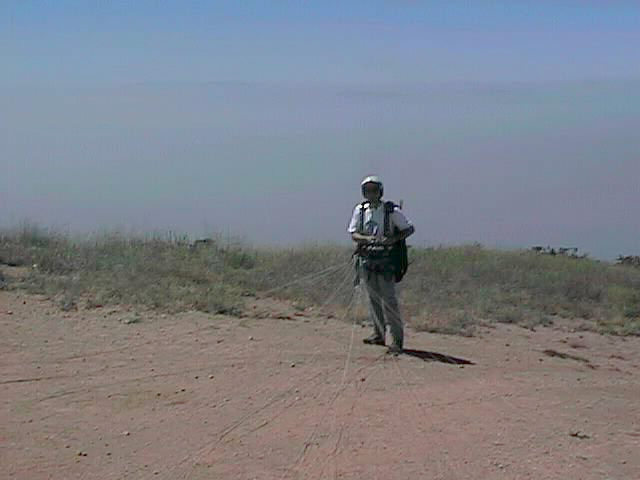
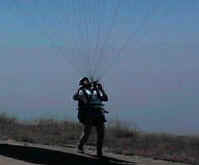
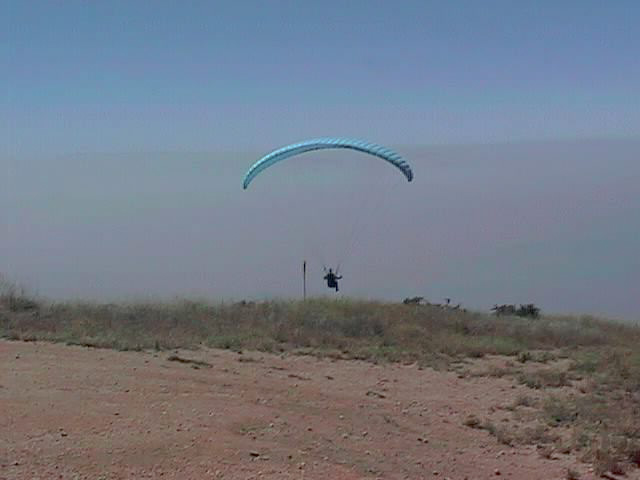


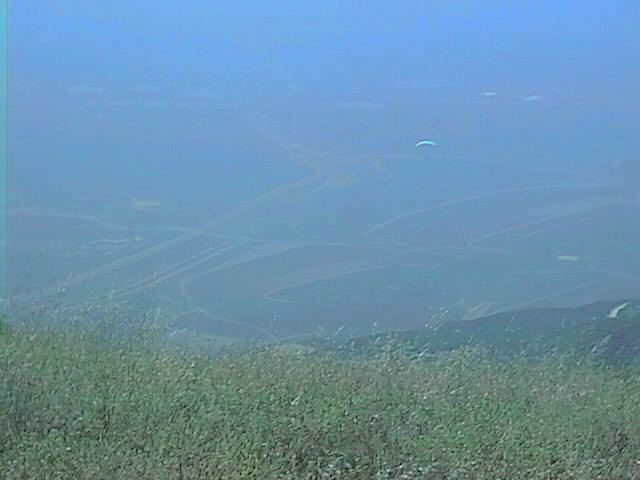
Joe Kucan Flies Next
Since Mark's flight made it all look so easy, Joe Kucan decided to give it a try. He sets up and waits for the wind to get better. We can't help but notice that the we will be launching through very tall weeds. These weeds are very stickery (this should be a word) and polleny (this too should be a word). I hope no one trips.
Well, Joe Kucan keeps waiting for the wind to improve. It was a long wait. Finally, he takes off to a sled run similar to Mark's.
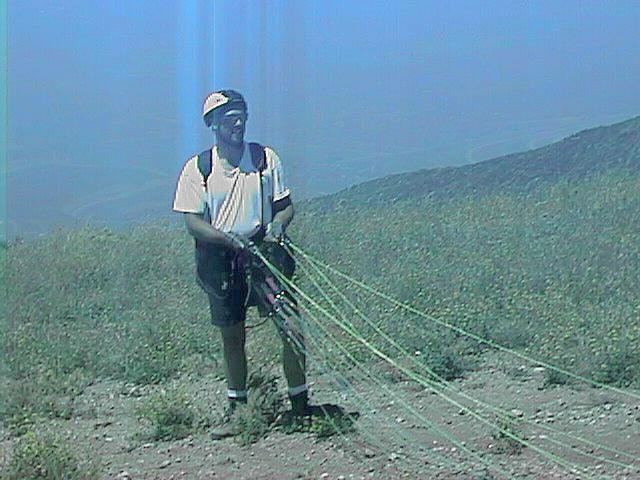

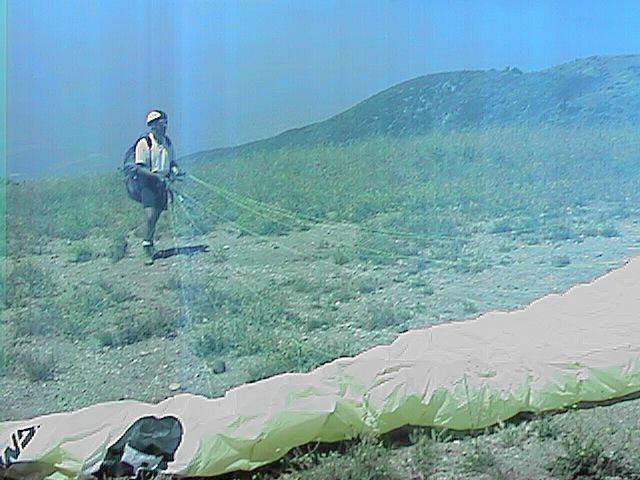
Ted's Turn
Ted decides to fly next. Since Ted is the least experienced paraglider pilot of the group, this was going to be interesting. Ted setup and launched very well. He was in radio contact with Kevin during the flight. There wasn't any lift for Ted either, so he was just sledding toward the landing zone. Mark was at the landing zone with a radio as well. From where we were, it was too far away to effectively give landing instructions, so Mark took over talking Ted down to a landing. Ted approached the landing zone too high and didn't S-turn enough to lose altitude. He overshot the landing zone! Fortunately, there was only low scrub brush around. He wasn't hurt, but he got well acquainted with the stickers that grew in this region, if you know what I mean.
It was my turn now. I was over a thousand feet above the ground on this flight -- the highest I've ever flown. From that height, the landing field looks about the size of a postage stamp. Compared with the wide open desert of our landing field in Nevada, this was quite exciting. Fortunately, landing was easier than it looked.
Lunch Time
After packing up, it is decided to eat lunch and then fly again later. Hopefully, the lift conditions will have improved by then. Off we go to Nick's Super Burger. Where else can you get a burger, fries, and drink for $2.95? We didn't bother looking for anything else since we were hungry and it was lunch time.
The food was good, but it was now time to fly. Off we go to the mountain top to fly again.
Hang Gliders
The peak has been transformed into a crowded airport. An airport consisting of hang gliders in various stages of assembly. The one thing I noticed most was that it sure takes a long time to set up a hang glider. They also have less freedom to launch anywhere. There was one preferred hang glider launch point. The hang gliders would 'taxi' down to the launch area queue. As each pilot launched, the rest would 'taxi' forward. It would take some time before all the gliders would launch.
Kevin Launches
Since paragliders set up so quickly and have greater launch area choices, Kevin decides to launch and check out the lift conditions. If it looks good, we get to fly!
Kevin suits up into a flight suit that reminds me of an astronaut's suit. It consists of;
a thermal protection flight suit to protect against the adiabatic induced temperature changes
an altimeter, variometer, and flight timer unit
a radio for ground communications (tuned to 144.555mgz)
a global positioning system unit for recording current Earth location
ocular protection
cranial protection
reserve parachute in case of catastrophic aircraft failure
After a thorough pre-flight check, it is time to take off.
Kevin flies and flies... straight up. Unlike the earlier flights, there seemed to be plenty of lift. That is the danger of flying at this time of day. The lift may be too strong. If the lift is too strong, it can cause the wing to collapse. This is less dangerous than it sounds, but can be quite unnerving, especially for our inexperienced selves.
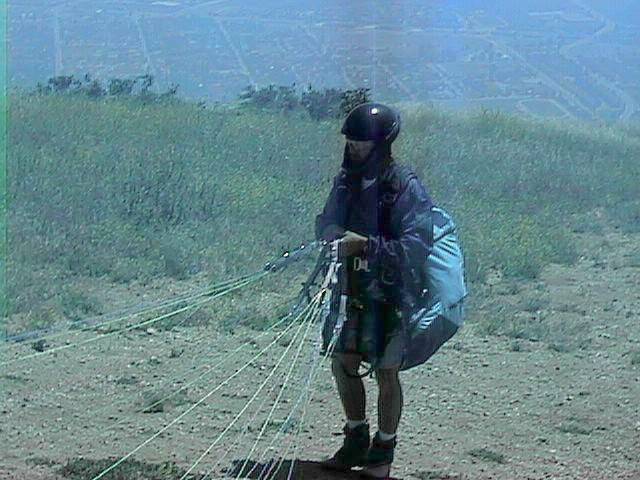
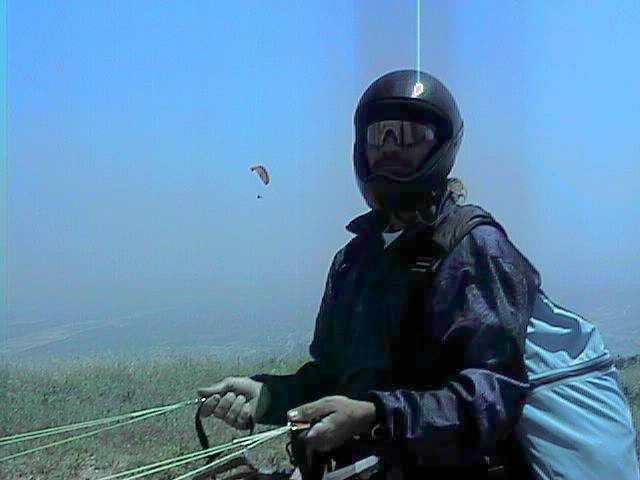
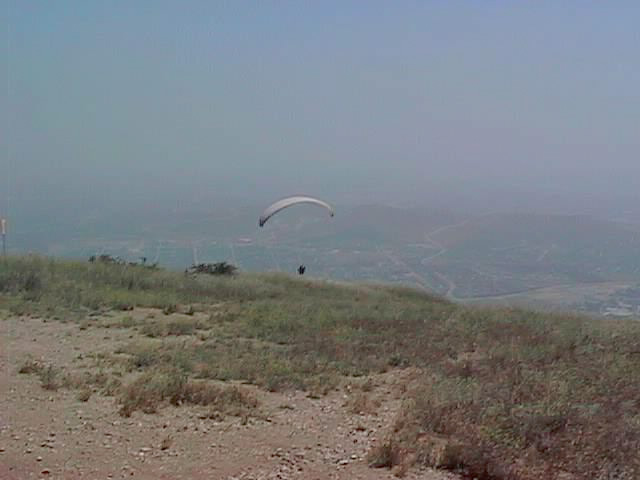
Crowded Launch Site
While we wait for Kevin to give us the go-ahead to fly, I should explain what the launch site was becoming. It was becoming crowded. That's what it was becoming. Just take a look at this picture. It seems that just about the time Kevin decided to take off, the paraglider pilots began arriving. Brian (another paraglider pilot from Las Vegas) also arrived.
Time To Fly
Kevin finally gives us the launch go ahead. Joe Kucan flies in and out of some thermals. Gaining lift and then losing lift. Since he didn't have a variometer, it would be difficult to detect and stay in lift. This flying style was described as "flopping around like a dead fish." However, there was lift and Joe was finding it. The flight was much longer than before.
Ted takes off and still under radio control, gets into lift and starts to climb. He climbed back up to launch altitude in a short period of time. Only later did we learn that Ted could not hear the radio (dead batteries perhaps?) and he was just getting lucky with the lift. Kevin didn't know the radio was out. I guess Kevin was so used to Ted not following radio directions very well that he didn't notice. You know, the "left, left, left, your other left Ted" episode.
I flew next. Wow, there sure was lift this time. My variometer would beep beep beep whenever I entered lift. Kevin could see when I was in lift and talked me through some turns. The most surprising thing I learned was just how steep the turning was. In order to stay in the thermal, it was necessary to turn much sharper than I was used to. Soon I got the hang of it and was gaining altitude fast. Up, up, up I went and soon was well above the launch point.
After an hour or so, I started to loose altitude. As I approached the landing zone but was still about 500 feet above it, I noticed a hawk circling. I figured if the hawk was circling in lift, I could too. I raced over to where the hawk was and presto! There was a thermal. Up, up, up I went again. All the way to the top of the thermal. Kevin and Brian and I were circling around up there all alone. It was so high that it was getting a bit chilly.
Kevin showed us a "B-line stall". This is where the second set of risers are pulled down such that the wing goes into a controlled partial collapse lengthwise down the wing. The result is rapid loss of altitude. As Brian and I struggled for the remaining bits of lift, Kevin landed.
Eventually, the lift died and I had to think about landing. While on landing approach Ted, Joe Kucan, Mark, and Kevin radioed that they were going to hitch a ride to the top and fly again. Brian and I land and fold up our wings.
Formation Landing
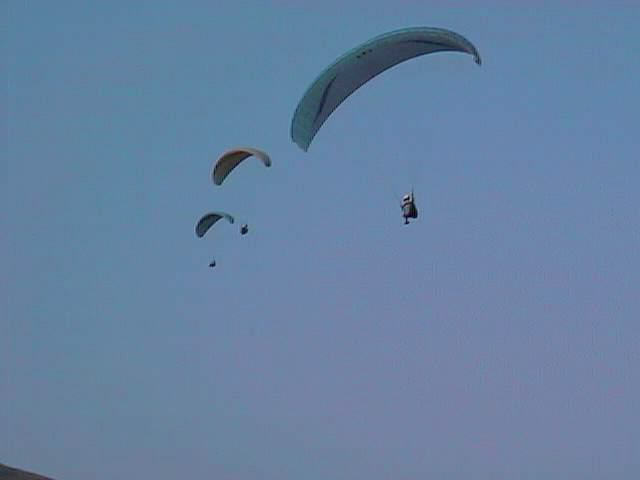
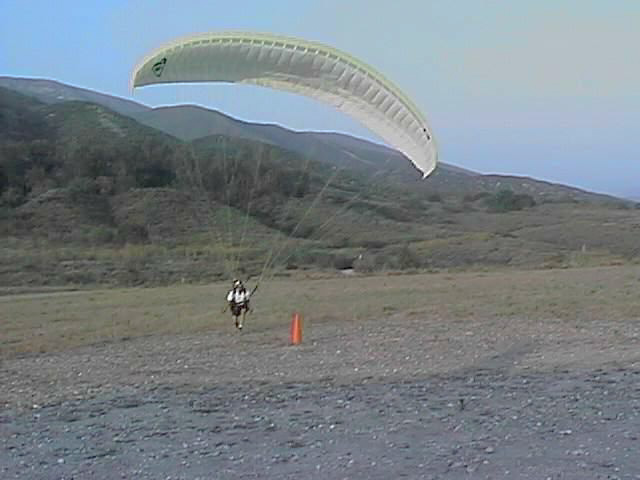
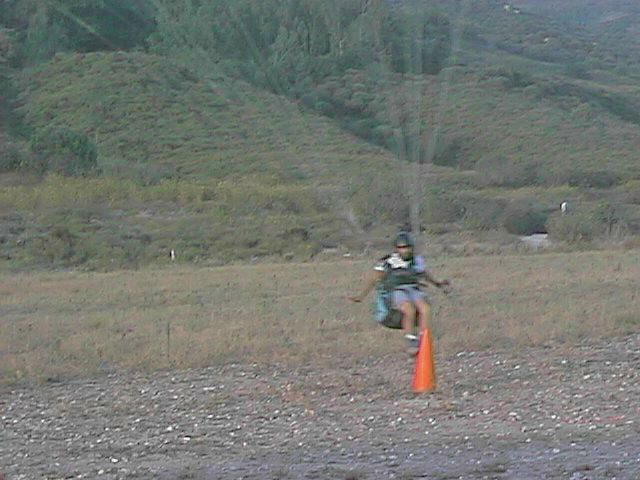

I see the group launch from the peak. The keep formation as they fly around. Just like a flock of geese. I suspected that because they launched at the same time, they will end up landing at the same time too.
Pack Up and Leave
It is time to pack up the wings and head home. The other paraglider and hang glider pilots are packing up as well. It was a day of great flying! We'll be back.
